1.Introduction
The nonlinear evolution equations have played a fundamental role in the field of mathematical physics and many other areas of applied science. As an instance, in signal processing, dusty plasma, fluid dynamics, nonlinear optics, quantum mechanics, biology, and so forth (1)-(6). Examining the exact solutions of these nonlinear models help us to understand the mechanism, application and gives better knowledge of the model. With the virtue of these solutions, a better vision can be captured into the physical feature of the considered model. In recent years, series of methods have been developed to obtain the exact and approximate solutions of the nonlinear evolution equations in mathematical physics, as an instance, the Jacobi elliptic function method 7, Adomian decomposition method 8, sine-cosine method 9,10, first integral method 11,12, variational iteration method 13,14, extended tanh method 15,16, q-homotopy analysis method 17-19, exp-function method20-22, q-homotopy analysis transform method 23-25, tanh-sech method 26,27, homotopy perturbation method (28), (G´/G)-expansion method 29,30, fractional reduced differential transform method 31,32, homogeneous balance method 33,34, inverse scattering method 35, iterative shehu transform method 36, homotopy analysis method 37,38, Jacobi elliptic expansion method 39,40, residual power series method 41-43, perturbation-iteration algorithm 44,45, modified Kudryashov method (46), new extended direct algebraic method 47, Sardar sub-equation method 48, Sine-cosine and sinh-cosh techniques 49, simple equation method 50 and so on.
The (3+ 1) -dimensional Zakharov-Kuznetsov (ZK) equation which comprises of the nonlinear term “PP x ”and third-order dispersion term “P xxx ” is restricted to the waves of small amplitudes only is presented by
where P represents electrostatic potential, the physical quantities A, B and C are constants. Seadawy et al. 51,52 and Zhen et al. 53 have outlined these physical quantities. The width of the soliton and its velocity deviate from the predictions of this equation when the amplitude of the wave increases. As a result, an additional fifth-order dispersion term which is a higher-order dispersion term, ‘‘EPxxxxx", is added to (1) to overcome this problem (see 51-54, for more detailed). The new perturbed -(3+1)dimensional ZK equation reads
In this present study, our objective is to further complement the previous studies conducted on the perturbed (3+1)-dimensional ZK equation by introducing the more general form by replacing the nonlinear term “PP x” with ‘‘PkPx". We now consider the generalized fractional form of this equation as
where k is a positive number, γ is the fractional-order and E is a smallness parameter. For this purpose, we have carefully proposed the sub-equation method of conformable type to find analytic closed-form solutions of (3). The solutions consist of the dark soliton, multi-soliton, kink-shape, solitary wave, bell-shaped solitons, and periodic solutions, which are all substantial in the field of mathematical physics. When γ=1, k=1, and E=0, (3) reduces to the standard Zakharov?Kuznetsov (ZK) equation (see (1). For γ = 1, k = 2 and E=0, (3) reduces to the modified KdV-ZK equation developed for a plasma comprised of cool and hot electrons and a species of fluid ions 55. The case when k = 1,2 and 4 are considered in this present study. It is worth mentioning that the case when γ = 1 and k = 1 in (3) have been investigated by the following authors. Elwakil et al. in 56 have studied the electron-acoustic solitary waves in a magnetized collisionless plasma consisting of a cold electron fluid and non-thermal hot electrons obeying a non-thermal distribution, and stationary. Ali et al. in 57 have investigated the exact solutions by using a sine-cosine method and modified Kudryashov methods and constructed six Lie point symmetries and nonlocal conservation laws for this equation. Recently, in 58, using two methods, Lie symmetry analysis and generalized exponential rational function. The authors present new exact solutions through optimal systems of one-dimensional Lie subalgebras; some solitary waves depict single soliton, multi-soliton, and annihilation profiles and six other closed-form solutions. To our knowledge, the case when k = 2 and k = 4 have not been studied before.
The rest of the paper is organized as follows: Section 2 gives a brief discussion of conformable derivatives which includes the definitions, basic properties, lemmas, and theorems. Section 3 presents the general idea of the sub-equation method. In 4, the application of sub-equation to time-fractional perturbed (3+1)-dimensional ZK equation of conformable type is demonstrated. In 5, the graphical representation of some solutions is depicted in 3D for different fractional orders. Finally, 6 gives the conclusion.
2.Preliminaries
This section contains a brief discussion of conformable derivatives, which includes the definitions, basic properties, lemmas, and theorems. Most of the concepts presented in this section have been introduced in 59,60
Definition 2.1. LetP:[0,∞)→R.The conformable derivative of P of order γ is given by
Furthermore, If P is γ-differentiable in some interval(0,ζ)whereζ>0,andlimt→0P(γ)(t)exists. We define
Lemma 2.2.59Letγ∈(0,1]and P, Q be γ-differentiable at a point t > 0. Then
Dγ(δ1P+δ2Q)=δ1DγP+δ2DγQ,∀δ1,δ2∈R.
Dγ(tσ)=σtσ-γ,∀σ∈R.
Dγ(PQ)=PDγQ+QDγP.
Dγ(PQ)=QDγP-PDγQQ2,providedQ≠0.
Dγ(C)=0,where C is a constant.
Lemma 2.3.59Let P be a differentiable and γ-differentiable function. Then
Theorem 2.4.61,62LetP:(0,∞)→Rbe a differentiable and γ-differentiable function. Let Q be a differentiable function defined in the range of P. Then
3.Algorithm of the proposed method
The main concept of the sub-equation method 63,64 for solving FPDEs is presented below:
Here, Dγt is defined according to 2 with fractional order γ and an unknown function P=P(x,y,z,t).
Step. 1: Let P(x,y,z,t)=P(ξ), ξ=px+qy+rz+s tγγ, where p, q, r and s are constants to be calculated respectively. With the help of the chain rule, we can transform Eq. (8) to an integer order nonlinear ODE given as
Step 2: We suppose that (9) has the solution:
where p,q,r,s and ej(j=0,1,⋯,N), are constants to be obtained accordingly. Balancing the highest-order derivative and biggest nonlinear term in Eq.(9) provides value for the integer N. The function ϑ(ξ) satisfies the Riccati equation:
where σ is a constant and the solutions are given as
Step 3: Substituting Eqs. (10) and (11) into Eq.(9), we have some polynomial in ϑj(ξ), (j=0,1,2⋯). Furthermore, setting the coefficients of ϑj(ξ) to zero, results set of nonlinear algebraic equations in p,q,r,s and ej(j=0,1,⋯,N).
Step 4: Finally, by solving the equations found in Step 3. Then, substitute these constants p,q,r,s,σ and ej into Eq.(10) in addition to Eq. (12), we conclude the desirable solutions for Eq. (8) immediately.
4.Sub-Equation Method to PZK Equations of Comformable Type
Here, the application of the sub-equation method to the time-fractional perturbed (3 + 1) -dimensional ZK equation of conformable type is presented. Consider
Application of chain rule on P(x,y,z,t)=P(ξ), ξ=px+qy+rz+stγγ reduces Eq. (13) to a nonlinear ODE given as
Balance principle to the terms PkP' and P''''' yields N=4k. To obtain closed-form solutions, N must be an integer; therefore, we choose k = 1,2 and 4.
4.1.Solutions for k = 1:
For k = 1, we have N = 4, then Eq.(10) gives
By substituting Eqs. (11) and (15) into Eq.(14), then equating the coefficients of ϑr(ξ) to zero yields
With the aid of Mathematica, we solve the above equations as
Case 1.
By substituting Eq.(17) into Eq.(15) with solutions defined in Eq.(12), we have the required solutions of Eq.(13) as:
P1=e0+3360Ep4σ2Atanh2(√-σ[px+qy+rz+sγtγ])-1680Ep4σ2Atanh4(√-σ[px+qy+rz+sγtγ]), σ>0,P2=e0+3360Ep4σ2Acoth2(√-σ[px+qy+rz+sγtγ])-1680Ep4σ2Acoth4(√-σ[px+qy+rz+sγtγ]), σ>0,P3=e0-3360Ep4σ2Atan2(√σ[px+qy+rz+sγtγ])-1680Ep4σ2Atan4(√σ[px+qy+rz+sγtγ]), σ<0,P4=e0-3360Ep4σ2Acot2(√σ[px+qy+rz+sγtγ])-1680Ep4σ2Acot4(√σ[px+qy+rz+sγtγ]), σ<0,P5=e0-1680Ep4A(px+qy±√-Bp2-Cq2Cz-Ae0pγtγ+ϕ)4, σ=0,
where ϕ is a constant, s=-Ae0p-1104Ep5σ2 and r=±√(-Bp2-Cq2+52Ep4σ)/C.
Case 2.
The required solutions for Eq.(13) are
P6=e0-1680iσ(√31Ep4σ+31iEp4σ)31Atanh2(√-σ[px+qy+rz+sγtγ])-1680Ep4σ2Atanh4(√-σ[px+qy+rz+sγtγ]), σ<0,P7=e0-1680iσ(√31Ep4σ+31iEp4σ)31Acoth2(√-σ[px+qy+rz+sγtγ])-1680Ep4σ2Acoth4(√-σ[px+qy+rz+sγtγ]), σ<0,P8=e0+1680iσ(√31Ep4σ+31iEp4σ)31Atan2(√σ[px+qy+rz+sγtγ])-1680Ep4σ2Atan4(√σ[px+qy+rz+sγtγ]), σ>0,P9=e0+1680iσ(√31Ep4σ+31iEp4σ)31Acot2(√σ[px+qy+rz+sγtγ])-1680Ep4σ2Acot4(√σ[px+qy+rz+sγtγ]), σ>0,P10=e0-1680Ep4A(px+qy±z√-Bp2C-q2-Ae0pγtγ+ϕ)4, σ=0,
where s=131(-31Ae0p-3720Ep5σ2+1368i√31Ep5σ2) and r=±√-Bp2C-26Ep4σC-78iEp4σ√31C-q2.
Case 3.
The required solutions for Eq.(13) are
P11=e0+1680iσ(√31Ep4σ-31iEp4σ)31Atanh2(√-σ[px+qy+rz+sγtγ])-1680Ep4σ2Atanh4(√-σ[px+qy+rz+sγtγ]), σ<0,P12=e0+1680iσ(√31Ep4σ-31iEp4σ)31Acoth2(√-σ[px+qy+rz+sγtγ])-1680Ep4σ2Acoth4(√-σ[px+qy+rz+sγtγ]), σ<0,P13=e0-1680iσ(√31Ep4σ-31iEp4σ)31Atan2(√σ[px+qy+rz+sγtγ])-1680Ep4σ2Atan4(√σ[px+qy+rz+sγtγ]), σ>0,P14=e0-1680iσ(√31Ep4σ-31iEp4σ)31Acot2(√σ[px+qy+rz+sγtγ])-1680Ep4σ2Acot4(√σ[px+qy+rz+sγtγ]), σ>0,P15=e0-1680Ep4A(px+qy±z√-Bp2C-q2-Ae0pγtγ+ϕ)4, σ=0,
where s=131(-31Ae0p-1368i√31Ep5σ2-3720Ep5σ2) and r=±√-Bp2C+78iEp4σ√31C-26Ep4σC-q2.
4.2.Solutions for k= 2:
When k = 2 we have N = 2 then Eq.(10) gives
By substituting Eqs. (20) and (11) into (14), then equating the coefficients of ECUACION to zero yields
With the help of Mathematica, we solve the above equations as
Case 1.
By substituting Eq.(22) into Eq.(20) and using the solutions defined in Eq.(12), we obtain the required solutions to Eq.(13) as:
P16=e0+6ip2σ√10EAtanh2(√-σ(px+qy+rz+sγtγ)), σ<0,P17=e0+6ip2σ√10EAcoth2(√-σ(px+qy+rz+sγtγ)), σ<0,P18=e0-6ip2σ√10EAtan2(√σ(px+qy+rz+sγtγ)), σ>0,P19=e0-6ip2σ√10EAcot2(√σ(px+qy+rz+sγtγ)), σ>0,P20=e0-6ip2√10E√A(px+qy±√i√10AEe0p2-Bp2-Cq2Cz-Ae20pγtγ+ϕ)2, σ=0,
where s=-8i√10√A√Ee0p3σ-Ae20p+184Ep5σ2 and r=±√i√10AEe0p2-Bp2-Cq2-40Ep4σC.
Case 2.
By substituting Eq.(23) into Eq.(20) and using the solutions defined in Eq.(12), we obtain the required solutions to Eq.(13) as:
P21=e0-6ip2σ√10EAtanh2(√-σ(px+qy+rz+stγγ)), σ<0,P22=e0-6ip2σ√10EAcoth2(√-σ(px+qy+rz+stγγ)), σ<0,P23=e0+6ip2σ√10EAtan2(√σ(px+qy+rz+stγγ)), σ>0,P24=e0+6ip2σ√10EAcot2(√σ(px+qy+rz+stγγ)), σ>0,P25=e0+6ip2√10E√A(px+qy±√-i√10AEe0p2-Bp2-Cq2Cz-Ae20pγtγ+ϕ)2, σ=0,
where s=8i√10AEe0p3σ-Ae20p+184Ep5σ2 and r=±√-i√10AEe0p2-Bp2-Cq2-40Ep4σC.
4.3.Solutions for k= 4:
When k = 4 we have N = 1, then Eq.(10) yields
By substituting Eqs. (24) and (11) into Eq.(14), then equating the coefficients of ϑr(ξ) to zero gives
By utilizing Mathematica, we solve the above equations as
Case 1:
By substituting Eq.(26) into Eq.(24) and using the solutions defined in Eq.(12), we obtain the required solutions to Eq.(13) as:
P26=±(1+i)p√-σ4√30EAtanh(√-σ[px+qy±√-Bp2-Cq2-20Ep4σCz+24Ep5σ2γtγ]),σ<0,P27=±(1+i)p√-σ4√30EAcoth(√-σ[px+qy±√-Bp2-Cq2-20Ep4σCz+24Ep5σ2γtγ]),σ<0,P28=∓(1+i)p√σ4√30EAtan(√σ[px+qy±√-Bp2-Cq2-20Ep4σCz+24Ep5σ2γtγ]),σ>0,P29=±(1+i)p√σ4√30EAcot(√σ[px+qy±√-Bp2-Cq2-20Ep4σCz+24Ep5σ2γtγ]),σ>0,P30=±(1+i)p4√30E4√A(px+qy±√-Bp2C-q2z+ϕ),σ=0.
Case 2:
By substituting Eq.(27) into Eq.(24) and using the solutions defined in Eq.(12), we obtain the required solutions to Eq.(13) as:
P31=±(-1+i)p√-σ4√30EAtanh(√-σ[px+qy±√-Bp2-Cq2-20Ep4σCz+24Ep5σ2γ]tγ),σ<0,P32=±(-1+i)p√-σ4√30EAcoth(√-σ[px+qy±√-Bp2-Cq2-20Ep4σCz+24Ep5σ2γtγ]),σ<0,P33=∓(-1+i)p√σ4√30EAtan(√σ[px+qy±√-Bp2-Cq2-20Ep4σCz+24Ep5σ2γtγ]),σ>0,P34=±(-1+i)p√σ4√30EAcot(√σ[px+qy±√-Bp2-Cq2-20Ep4σCz+24Ep5σ2γtγ]),σ>0,P35=±(-1+i)p4√30E4√A(px+qy±√-Bp2C-q2z+ϕ),σ=0.
5.Graphical representation of some solutions
The absolute behavior in 3D plots with integer and fractional order respectively γ=1, γ=0.75, and 0.5 are presented for some solutions in Fig.1-8. These plots reveal different structures such as the dark soliton, multi-soliton, solitary wave, bell-shaped soliton, periodic and kink-type solutions which give the readers a better vision of the behavior of these solutions and captured some physical features of the considered model. Furthermore, Fig.7 and 8 display the effect of adding a new perturbation term on the profile of the solution.

Figure 1 The plots of P1 solution for A = 1; B = 2; C = -20; y = z = 2; E = 0:5; σ = -1; e0 = 0:5; p = 0:2 and q = 0:2:
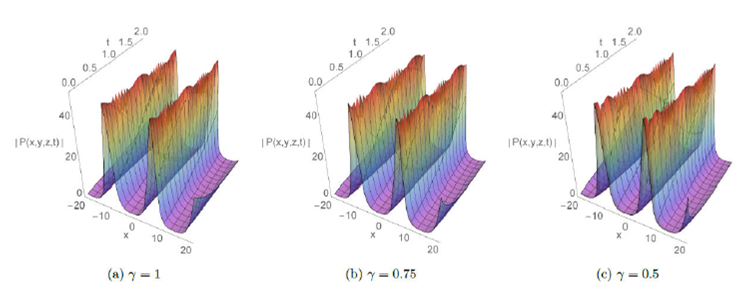
Figure 2 The plots of P3 solution for A = 1; B = 2; C = -20; y = z = 2; E = 0:5; – = 1; e0 = 0:5; p = 0:2 and q = 0:2:
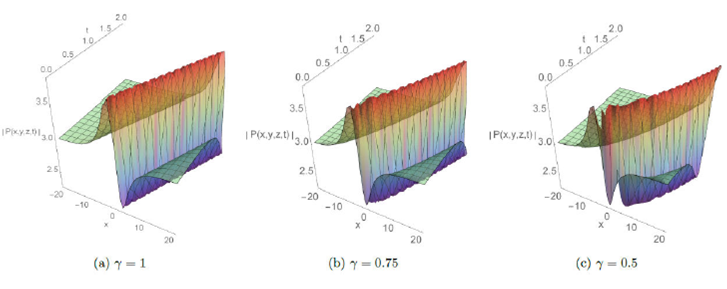
Figure 3 The plots of P20 solution for A = 1; B = 2; C = -1; y = z = 2; E = 0:5; φ = 1; e0 = 3; p = 0:2 and q = 0:2:
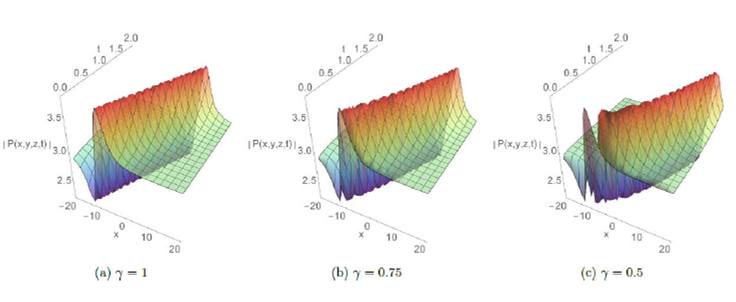
Figure 4 The plots of P25 solution for A = 1; B = 2; C = -1; y = z = 2; E = 0:5; φ = 1; e0 = 3; p = 0:2 and q = 0:2:
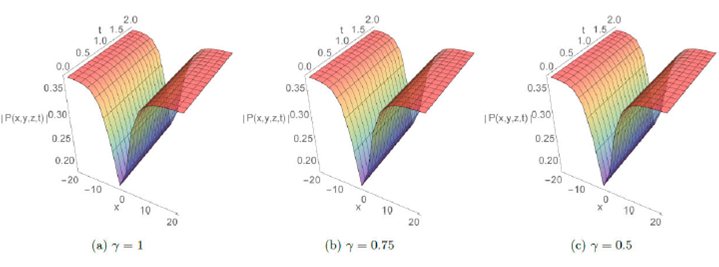
Figure 5 The plots of P26 solution for A = 1; B = 2; C = 10; y = z = 2; E = 0:1; σ = -1; e0 = 3; p = 0:2 and q = 0:2:
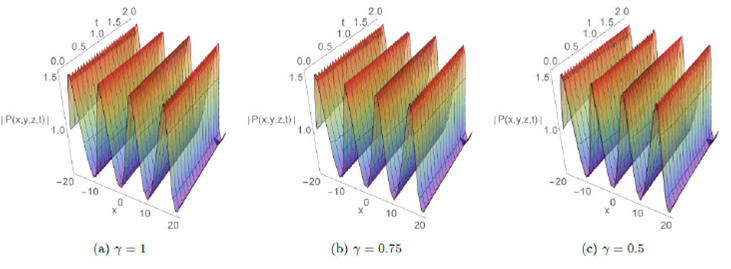
Figure 6 The plots of P28 solution for A = 1; B = 2; C = 10; y = z = 2; E = 0:8; σ = 1; e0 = 3; p = 0:3 and q = 0:3:

Figure 7 The effect of the parameter E on solution profile of P11 for γ = 1; A = 1; B = 2; C = 10; y = z = 2; σ = -1; e0 = 3; p = 0:5 and q = 0:5:
6.Conclusion
In this paper, we introduced the generalized time-fractional perturbed (3+1) Zakharov-Kuznetsov (PZK) equations which describe the nonlinear dust-ion-acoustic waves in the magnetized two-ion-temperature dusty plasmas. We investigate the exact solutions by the use the of sub-equation method in the conformable sense. The use of conformable derivative in this study gives flexibility when applying to the proposed model and satisfies the power rule, product rule, quotient rule, integration by parts, chain rule, linearity, and the derivatives with constant is zero. The newly obtained solutions by the proposed method are, respectively, the dark soliton multi-soliton, kink-shape, solitary wave, periodic and bell-shaped soliton solutions that are significant in the field of mathematical physics. Graphical representation (see Fig. 1 to 8) of obtained solutions are plotted in 3D for particular values of parameters. Figures 7 and 8, demonstrate the effect of adding a higher-order dispersion term ‘‘EPxxxxx" to Eq.(1). The performance of this method is reliable and effective and the obtained results are in a more general form. Finally, through Mathematica, we have authenticated the obtained solutions by substituting them back into the proposed equation.











 nueva página del texto (beta)
nueva página del texto (beta)



